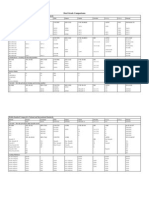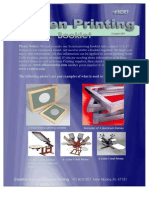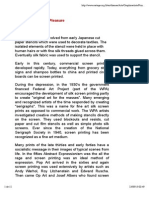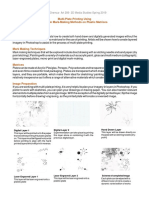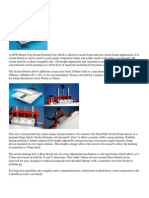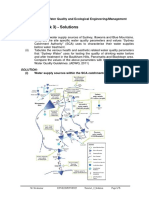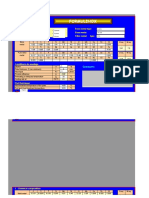Introduction To Screen Printing: Creating Your Stencil
Introduction To Screen Printing: Creating Your Stencil
Uploaded by
Anonymous F4YGUk9fCopyright:
Available Formats
Introduction To Screen Printing: Creating Your Stencil
Introduction To Screen Printing: Creating Your Stencil
Uploaded by
Anonymous F4YGUk9fOriginal Description:
Original Title
Copyright
Available Formats
Share this document
Did you find this document useful?
Is this content inappropriate?
Copyright:
Available Formats
Introduction To Screen Printing: Creating Your Stencil
Introduction To Screen Printing: Creating Your Stencil
Uploaded by
Anonymous F4YGUk9fCopyright:
Available Formats
INTRODUCTION TO SCREEN PRINTING
Screen printing is a great introduction to the art of
printmaking. Printmaking was originally a form of
communication before becoming an art form. With
the advent of the printing press, art prints began to
be valued as originals and in the 19th century
artists began producing limited edition prints.
This handout is intended to introduce the beginner
printmaker to the basic steps of screen printing. All
the supplies listed are readily available and have
been used with success by beginners, educators and
pros alike. With a bit of practice, you too can
make great silkscreen prints.
Materials:
Pre-stretched silk screen(s)
Squeegee
Screen printing hinge clamps
Waterproof tape (1" wide)
Self-adhesive stencil material
Screen printing ink
Strips of card or poster board
Small scrub brush & household detergent
X-Acto knife
Containers
Old or disposable spoons
Pencils or pens
Drawing and Printmaking Paper
Old towels, rags or paper towels
Rubber gloves and protective clothing
Hair dryer
Cord or clothesline
Bulldog clips and clothes pins
Screen Block Fluid
GETTING STARTED
Ideally you will need a large work space for silk
screen printing which allows room for inks, screens,
and hanging or laying out your finished prints to dry.
You will also need access to hot and cold running
water, ventilation and a good light source.
To begin, lay out newspapers or plastic to protect
your work surface. If you are planning to hang your
prints up to dry, string a clothesline and have enough
OPUS Framing & Art Supplies
clothes pins handy to
accommodate the
number of prints you
will be producing.
At this stage, you
can also set up your
work surface by
attaching the hinge
clamps to a board or directly to the table top. You will
need these when you are ready to begin printing.
Screw securely
onto work surface.
CREATING
YOUR STENCIL
The most basic form of screen printing is using
stencils attached to the outside of your screen. If this is
your first time screen printing, choose a simple image
which will use only one or two colours in the printing
process. After you become comfortable with screen
printing, you can experiment with more complicated
imagery and additional colours.
Design your image directly on a thick piece of
paper or special stencil paper, which will be cut into a
stencil, or design your image on a
piece of paper to be transferred to a
specialty stencil paper or adhesive
masking film. Keep in mind that a
stencil cut from regular drawing
paper wont last.
Tip: When image orientation is important, be sure your
stencil is adhered the right way around for printing. This is
particularly important if using an adhesive stencil paper, or
letters and numbers, as your stencil can only be adhered to
your screen one way.
With all stencils, remember that the parts of the
image which you cut away will allow ink through the
screen and onto the paper. The parts of the stencil
which are left, will block out the ink and take on the
colour of the paper.
If a multiple colour print is desired, a simple
design is easier to process for two to three colour
printing. You can either block out design areas on a
single stencil as you print each colour, or you can
prepare two screens with two different stencils, each
Page 1
INTRODUCTION TO SCREEN PRINTING
using a different colour.
Brown
Green
Before you begin cutting your
stencil, try colouring it in or
numbering the areas you want
to cut away to help you
envision the final print.
Registration is necessary
Red
when using multiple colours
in a print to ensure that your
colours will line up correctly
Non-printing area of stencil
and to prevent different
will be the colour of the paper.
colours from overlapping
when this is not desired. Registration will also prevent
areas of the paper from showing through colours that
are intended to overlap. An easy solution for
registration is discussed on page 3 of this handout.
Once you are comfortable with basic screen
printing you can consult a book for more complex
images, methods and techniques.
Cutting Your Stencil
After you have prepared your artwork, you can
cut your artwork as is or transfer your work on to a
sheet of stencil paper. To transfer it, simply use carbon
or transfer paper. When cutting your stencil keep in
mind that clean lines will produce a sharp image. We
suggest using a quality sharp blade such as a #1 XActo knife to make your cutting easier.
Tip: Move the stencil material under the knife, as you
cut, to make clean lines easier to achieve.
Mask-Ease is a common two part vinyl and
adhesive stencil material used for screen printing. Cut
your stencil from the sheet of vinyl and then apply the
transfer sheet of weak adhesive.
Flip your stencil to remove the
Stencil sheet
liner from the vinyl sheet.
Apply the adhesive side of the
vinyl with even pressure to the
outside of your screen. When
using stencil material, be sure to
read through the manufacturer's
instructions before use.
OPUS Framing & Art Supplies
SCREEN PREPARATION
Although pre-stretched screens are ready to use,
you should always clean your screen with a scrub
brush and detergent before use. This will eliminate
any soil that may have deposited on the screen during
manufacture, transport or storage. Be sure to dry the
screen thoroughly as your stencil material will not
stick to your screen if it is damp. You can use a hair
dryer to speed up the drying process if desired.
Adhere the stencil to the outside of your clean, dry
screen and apply enough pressure to ensure that the
stencil is well-adhered. Next, using a water-resistant
tape approximately 1.5" wide, run it along the inside
of the screen. Position the tape so that half is on the
screen itself, and half is on the screen frame. This
border of tape will keep your screen printing ink from
seeping between the edges of your screen and frame
and in effect ruining your print.
Note: This step will reduce the printable area of the
screen, and your design should be sized for this final set of
dimensions. Rub or burnish the tape well to ensure
proper adhesion.
Next, set the screen up for printing by attaching it
to your printing base with hinge clamps. The screen
must be placed with the flattest (or outside) side of the
screen down. The base can either be a table top or a
wooden board that is sufficiently thick to fit the clamp.
The board also needs to be heavy enough to remain
stable while the screen is being raised and lowered.
PRINTING &
REGISTRATION
Be sure to have all of your necessary materials and
equipment in place before you start printing. If you
are using colours straight from their containers, it is a
good idea to transfer a portion of each colour you
want to use to other containers to avoid potential
contamination of the unused ink.
Next, place a couple of spoonfuls of screen
printing ink across the bottom edge of the screen,
closest to you. With the screen lifted slightly off the
surface of the printing base, use the squeegee to pull
Page 2
INTRODUCTION TO SCREEN PRINTING
the ink across the screen, in one stroke (away from
you). Hold the squeegee at a forty-five degree angle so
that only the leading edge of the rubber strip contacts
the screen. This will flood the screen with printing ink.
Next, prop the screen up and place a piece of test
paper under the screen which has been pre-cut to the
desired size. Position your paper and pull a test print
to ensure that your image
Pull or print stroke
at 45 degree angle
is centered. To make the
print, lower the screen
onto the paper, and pull
the squeegee, again
Cross-section
holding it at a forty-five
Screen
degree angle toward you, of frame
this time with a firm
Table
single stroke.
Immediately after you pull your print and while
the screen is lifted slightly, do another light flood
stroke away from you, and prop the screen up. Using
a flood stroke helps keep the ink from drying in the
screen and blocking it.
Once the paper is correctly positioned, tape two
pieces of card against the bottom of the paper, and one
against the side. These pieces of card are
now your registration guides and each
subsequent piece of paper will be
aligned with these registration guides to
ensure that each print lines up correctly.
This is helpful for both one colour and
multiple colour printing.
Once your registration guides are set
you may need to try further test prints to
practice handling the squeegee, and to
see whether there are any areas of your image that
need changing. To make changes on your screen, you
can block out areas that you no longer wish to print
with tape or screen block fluid, however, if you want
areas to print that are not cut out, you will have to
create a new stencil and screen.
When you are ready to begin your actual print
run, lower the screen, and pull the squeegee towards
you. Lift, do another flood stroke. This will become a
familiar rhythm of working after a while.
Following are two simple options for working
with multiple colour prints:
OPUS Framing & Art Supplies
1. If you are using a design with clearly separated
colour areas, the screen can be prepared for a second
colour by simply blocking out areas that you do not
want to print. This blocking out is done before
printing the first colour to reserve areas for the second
colour. You can use either masking tape on the
underside of the screen, or screen block fluid on top of
the screen. Screen block fluid is harder to remove and
if the screen is to be reused, you might want to stick
with masking tape for this process. Use the
registration guides to make sure the prints are aligned
when making the second print run.
2. You can also choose to create a new screen and
stencil for each colour you want to print. Or, you can
use the same screen, using a new stencil but being
sure to clean and dry it before using a new colour.
This is useful for images where colour areas will
overlap, and therefore cannot be simply blocked out
during printing. Registration between screens is
important with this method.
Another way to make registration easier with
more complex images is to create your stencils with a
slight tolerance where colour overlaps. For example, a
stencil with a red circle and a black outline
around it could be cut so that the red circle is
slightly bigger than intended. Print the red circle
first, knowing that the opaque black ink will
cover the red area of tolerance. This will help to
ensure that no distracting gaps will appear
between the red and black design areas.
Although the colours actually overlap they will
appear to just be printed cleanly side by side.
To test your second colour, place a test print
from the first colour run under the screen prepared
with the stencil which has been cut for the second
colour run. Make your print and check for accuracy of
registration. If there are gaps between areas that
should butt against each other, or colours overlapping
in areas where they shouldnt, realign the screen and
try again. Do this until the image is registered to your
satisfaction. You can then proceed with the second
colour print run.
As screen printing inks are available in both
opaque and transparent colours, it is important to plan
the order of your colours for printing accordingly. If
Page 3
INTRODUCTION TO SCREEN PRINTING
the second colour you print is opaque, it will cover the
previous colour, or if it is transparent it will create a
new colour.
When you have finished your run or edition of
prints, clean the screen and other equipment
immediately. This is especially important when using
permanent or acrylic screen printing ink, as it will ruin
the screen if allowed to dry.
DRYING
really large edition, the first prints should be dry by
the time the later ones are being made. It will then be
possible to stack them to clear the space for more
screen prints.
Tip: Always make sure that the first colour is dry before
printing the second colour, when printing multiple
coloured prints.
NOTES:
Place all prints in a safe place to dry. Although
many screen printing inks that are available now are
water-based and quick drying, it is still necessary to
provide proper drying time to reduce the possibility of
smearing. Print racks are often too expensive for most
people printing in a home studio or work space, so it
is best to make sure ahead of time that you have
plenty of space to either spread the prints out as they
dry, or create a clothesline effect with clothes pins or
bull dog clips to hang the prints from. In the case of a
OPUS
Framing &
OPUS Vancouver
1360 Johnston St
604-736-7028
Art Supplies
OPUS Langley
20484 Fraser Hwy
604-533-0601
OPUS Victoria
512 Herald St
250-386-8133
OPUS Kelowna OPUS North Vancouver OPUS National
1357 Ellis St
120 Lonsdale Ave
Mail Order Service
250-763-3616
604-904-0447
1-800-663-6953
where artists prefer to shop
OPUS Framing & Art Supplies
www.opusframing.com
Page 4
You might also like
- (DIY) Silk Screen Printing Instructions 한글No ratings yet(DIY) Silk Screen Printing Instructions 한글18 pages
- L) Screen Printing: Document 2, Health and Safety: Pages 6-7No ratings yetL) Screen Printing: Document 2, Health and Safety: Pages 6-710 pages
- Silk-Screen Printing for Artists and CraftsmenFrom EverandSilk-Screen Printing for Artists and Craftsmen3.5/5 (3)
- Introduction To Screen Printing: Creating Your StencilNo ratings yetIntroduction To Screen Printing: Creating Your Stencil4 pages
- Screenprinted Waterslide Transfers: The Basics: Basic Principles of Screen-Printing in GeneralNo ratings yetScreenprinted Waterslide Transfers: The Basics: Basic Principles of Screen-Printing in General5 pages
- Water Based Printing For Beginners Ebook v1 PDFNo ratings yetWater Based Printing For Beginners Ebook v1 PDF37 pages
- In A General Sense, A Print Edition Is The SET of ALL The Impressions Made From The SAME MatrixNo ratings yetIn A General Sense, A Print Edition Is The SET of ALL The Impressions Made From The SAME Matrix76 pages
- Creative Science - Research - Screen Printing (2003) PDF100% (1)Creative Science - Research - Screen Printing (2003) PDF29 pages
- Halftone Perfection Checklist: Art, File Preparation, & Resolution ParametersNo ratings yetHalftone Perfection Checklist: Art, File Preparation, & Resolution Parameters8 pages
- Dupont Artistri Xite Dye Sublimation InksNo ratings yetDupont Artistri Xite Dye Sublimation Inks5 pages
- Cyanotype The Blueprint in Contemporary Practice 1st Edition Christina Z Anderson Ebook All Chapters PDF100% (3)Cyanotype The Blueprint in Contemporary Practice 1st Edition Christina Z Anderson Ebook All Chapters PDF25 pages
- Silk Screen Color Printing - Presenting a New Addition to the Graphic Arts-Serigraphy - A Demonstration and Explanation of the Process of Making 'Multiple Original' Color PrintsFrom EverandSilk Screen Color Printing - Presenting a New Addition to the Graphic Arts-Serigraphy - A Demonstration and Explanation of the Process of Making 'Multiple Original' Color PrintsNo ratings yet
- Digital Printmaking: Pixels, Dots, and Ink JetsNo ratings yetDigital Printmaking: Pixels, Dots, and Ink Jets9 pages
- Bromide Printing and Enlarging A Practical Guide to the Making of Bromide Prints by Contact and Bromide Enlarging by Daylight and Artificial Light, With the Toning of Bromide Prints and EnlargementsFrom EverandBromide Printing and Enlarging A Practical Guide to the Making of Bromide Prints by Contact and Bromide Enlarging by Daylight and Artificial Light, With the Toning of Bromide Prints and EnlargementsNo ratings yet
- Hand Cut Screen Printing: Stuarts Draft High SchoolNo ratings yetHand Cut Screen Printing: Stuarts Draft High School22 pages
- Pickup Manufacturer's Color Codes: Pickup Manufacturer Adjustable Pole Winding Direction Notes and Special InstructionsNo ratings yetPickup Manufacturer's Color Codes: Pickup Manufacturer Adjustable Pole Winding Direction Notes and Special Instructions1 page
- Acoustical Society of America ASA/EAA/DAGA '99 Meeting Lay Language Papers0% (1)Acoustical Society of America ASA/EAA/DAGA '99 Meeting Lay Language Papers3 pages
- Making Your Own Envelopes... : MaterialsNo ratings yetMaking Your Own Envelopes... : Materials2 pages
- Mask Making Ideas & Materials: Plaster MasksNo ratings yetMask Making Ideas & Materials: Plaster Masks4 pages
- T.T.I. - Tubacex Tubos Inoxidables, S.A.: Mill Test CertificateNo ratings yetT.T.I. - Tubacex Tubos Inoxidables, S.A.: Mill Test Certificate3 pages
- How To Make A Folding Sawhorse: Things You'll NeedNo ratings yetHow To Make A Folding Sawhorse: Things You'll Need5 pages
- Design and Fabrication of Aluminium Tin Can Crusher: A.S.Shinde, A.D. Landge, A.K. Biradar, S.M. KondawarNo ratings yetDesign and Fabrication of Aluminium Tin Can Crusher: A.S.Shinde, A.D. Landge, A.K. Biradar, S.M. Kondawar6 pages
- Surface Active Element Effects On The Shape of GTA, Laser, and Electron Beam WeldsNo ratings yetSurface Active Element Effects On The Shape of GTA, Laser, and Electron Beam Welds6 pages
- Science 6 (MODULES 7-8) Write The Letter in Column B That Corresponds To The Statements in Column A. Column A Column BNo ratings yetScience 6 (MODULES 7-8) Write The Letter in Column B That Corresponds To The Statements in Column A. Column A Column B2 pages
- ENVE220 ENVE925 Tutorial 2 Solutions-UpdatedNo ratings yetENVE220 ENVE925 Tutorial 2 Solutions-Updated6 pages
- L) Screen Printing: Document 2, Health and Safety: Pages 6-7L) Screen Printing: Document 2, Health and Safety: Pages 6-7
- Silk-Screen Printing for Artists and CraftsmenFrom EverandSilk-Screen Printing for Artists and Craftsmen
- Introduction To Screen Printing: Creating Your StencilIntroduction To Screen Printing: Creating Your Stencil
- Screenprinted Waterslide Transfers: The Basics: Basic Principles of Screen-Printing in GeneralScreenprinted Waterslide Transfers: The Basics: Basic Principles of Screen-Printing in General
- In A General Sense, A Print Edition Is The SET of ALL The Impressions Made From The SAME MatrixIn A General Sense, A Print Edition Is The SET of ALL The Impressions Made From The SAME Matrix
- Creative Science - Research - Screen Printing (2003) PDFCreative Science - Research - Screen Printing (2003) PDF
- Halftone Perfection Checklist: Art, File Preparation, & Resolution ParametersHalftone Perfection Checklist: Art, File Preparation, & Resolution Parameters
- Cyanotype The Blueprint in Contemporary Practice 1st Edition Christina Z Anderson Ebook All Chapters PDFCyanotype The Blueprint in Contemporary Practice 1st Edition Christina Z Anderson Ebook All Chapters PDF
- Silk Screen Color Printing - Presenting a New Addition to the Graphic Arts-Serigraphy - A Demonstration and Explanation of the Process of Making 'Multiple Original' Color PrintsFrom EverandSilk Screen Color Printing - Presenting a New Addition to the Graphic Arts-Serigraphy - A Demonstration and Explanation of the Process of Making 'Multiple Original' Color Prints
- Inkjet Printing on Fabric: Direct TechniquesFrom EverandInkjet Printing on Fabric: Direct Techniques
- Bromide Printing and Enlarging A Practical Guide to the Making of Bromide Prints by Contact and Bromide Enlarging by Daylight and Artificial Light, With the Toning of Bromide Prints and EnlargementsFrom EverandBromide Printing and Enlarging A Practical Guide to the Making of Bromide Prints by Contact and Bromide Enlarging by Daylight and Artificial Light, With the Toning of Bromide Prints and Enlargements
- A Complete Guide to the Ornamental Leather WorkFrom EverandA Complete Guide to the Ornamental Leather Work
- Inside Acrylics: Studio Secrets From Today's Top ArtistsFrom EverandInside Acrylics: Studio Secrets From Today's Top Artists
- Hand Cut Screen Printing: Stuarts Draft High SchoolHand Cut Screen Printing: Stuarts Draft High School
- Pickup Manufacturer's Color Codes: Pickup Manufacturer Adjustable Pole Winding Direction Notes and Special InstructionsPickup Manufacturer's Color Codes: Pickup Manufacturer Adjustable Pole Winding Direction Notes and Special Instructions
- Acoustical Society of America ASA/EAA/DAGA '99 Meeting Lay Language PapersAcoustical Society of America ASA/EAA/DAGA '99 Meeting Lay Language Papers
- T.T.I. - Tubacex Tubos Inoxidables, S.A.: Mill Test CertificateT.T.I. - Tubacex Tubos Inoxidables, S.A.: Mill Test Certificate
- How To Make A Folding Sawhorse: Things You'll NeedHow To Make A Folding Sawhorse: Things You'll Need
- Design and Fabrication of Aluminium Tin Can Crusher: A.S.Shinde, A.D. Landge, A.K. Biradar, S.M. KondawarDesign and Fabrication of Aluminium Tin Can Crusher: A.S.Shinde, A.D. Landge, A.K. Biradar, S.M. Kondawar
- Surface Active Element Effects On The Shape of GTA, Laser, and Electron Beam WeldsSurface Active Element Effects On The Shape of GTA, Laser, and Electron Beam Welds
- Science 6 (MODULES 7-8) Write The Letter in Column B That Corresponds To The Statements in Column A. Column A Column BScience 6 (MODULES 7-8) Write The Letter in Column B That Corresponds To The Statements in Column A. Column A Column B











